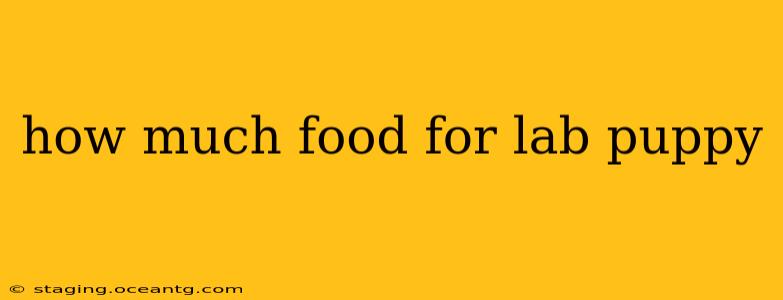How Much Food for a Lab Puppy: A Comprehensive Guide
Labrador Retrievers are known for their energetic and playful nature, and providing them with the right nutrition is crucial for their healthy growth and development. Determining the correct food amount for your Lab puppy depends on several factors, including their age, weight, activity level, and the specific food you're using. This guide will help you navigate the complexities of puppy nutrition and ensure your furry friend thrives.
What Factors Determine My Lab Puppy's Food Needs?
Several key factors influence how much food your Lab puppy needs daily. Let's break them down:
-
Age: Puppies have drastically different nutritional requirements than adult dogs. Younger puppies need more frequent, smaller meals to support rapid growth. As they age, their feeding schedule and portion sizes will adjust. Check the feeding guidelines on your chosen puppy food packaging; these guidelines are usually age-based.
-
Weight: A larger, heavier puppy will naturally require more food than a smaller, lighter one. Regularly weighing your puppy and adjusting their food intake accordingly is essential.
-
Activity Level: Highly active Lab puppies, those involved in extensive playtime or training, will need more calories than less active pups. Think about your puppy's daily exercise routine and adjust their food intake to match their energy expenditure.
-
Breed: Labrador Retrievers are a larger breed, meaning they have higher calorie requirements compared to smaller breeds. Their nutritional needs should reflect this.
-
Food Type: Different puppy foods have varying calorie densities. A food with a higher calorie content per cup will require a smaller volume to meet your puppy's needs compared to a lower-calorie food. Always carefully read and follow the feeding guidelines on your chosen food's packaging.
How Much Should I Feed My Lab Puppy?
There's no single "magic number" for how much to feed a Lab puppy. The best approach is to use the feeding guidelines printed on your puppy food bag as a starting point. These guidelines usually provide a range based on your puppy's weight.
However, remember that these are just guidelines. Closely monitor your puppy's weight and body condition. A healthy puppy should have a visible waistline and ribs that are easily felt but not prominent. If your puppy is gaining weight too quickly, reduce the food amount. If they seem too thin, slightly increase it.
What if I'm Unsure About the Right Amount?
If you're unsure how much to feed your Lab puppy, consulting your veterinarian is crucial. They can assess your puppy's individual needs based on their age, breed, weight, and overall health. They can also help you choose a puppy food appropriate for your dog's age and nutritional requirements.
How Often Should I Feed My Lab Puppy?
Puppies, especially younger ones, benefit from several smaller meals throughout the day. A common feeding schedule is 3-4 meals per day for puppies under 6 months old. As they grow older, you can gradually reduce the number of meals to 2 per day.
What Are the Signs of Overfeeding or Underfeeding?
Identifying the signs of overfeeding or underfeeding is crucial for your puppy's well-being:
Signs of Overfeeding:
- Weight gain: Your puppy is getting noticeably chubbier and losing their defined waistline.
- Lethargy: They're less active and seem tired more often.
- Obesity: This can lead to serious health problems later in life.
Signs of Underfeeding:
- Weight loss: Your puppy is losing weight and their ribs are overly prominent.
- Lethargy: Similar to overfeeding, underfeeding can also lead to decreased energy.
- Poor coat condition: Their fur may appear dull and dry.
Remember, responsible pet ownership involves regularly monitoring your puppy's weight and adjusting their food intake as needed. Always consult with your veterinarian if you have any concerns about your puppy's nutrition. Your vet is your best resource for ensuring your Lab puppy receives the optimal diet for healthy growth and a long, happy life.
